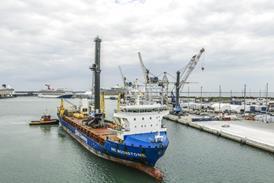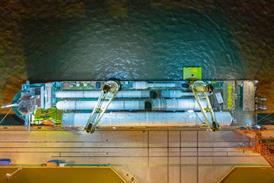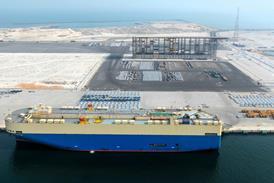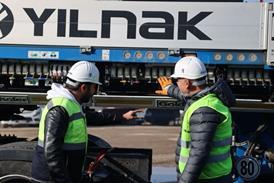February 24 - Heavy lifting and transportation specialist, Vanguard, was contracted to assist with the rigging of the single satellite dish 24 m off ground at the High Energy Stereoscopic System (HESS), located 100 km southwest of Windhoek in the Khomas H
To increase the energy coverage, sensitivity and angular resolution of the world's largest and most sensitive gamma-ray telescope, a large Cherenkov telescope (LCT) was added to the centre of four smaller telescopes.
"We first had to conduct a rigging study and draw up a lifting plan to determine the position of the drive rings, before lifting, placing and connecting thedrive rings to the main dish structure. Once complete, a strand-jack system was installed onto temporary lifting platforms to lift and position the dish, weighing 415 tonnes with dimensions of 25 m x 32 m," says Roland Cumings, Vanguard engineer.
The project was complicated by having to develop and implement a lifting plan based on the existing lifting framework, previously designed by BKS. As the rigidity and mechanical stability of the dish were of the utmost importance, precision placement and interfacing between the lifts were critical.
The drive rings were built on pedestals in a designated position according to the lifting plan, before being lifted and placed onto the structure. To enable placement, Vanguard used two mobile cranes from Wesbank Transport, with a lifting capacity of 400 and 170 tonnes respectively. The drive rings were first topped and tailed, before being levelled with a sling and chain-block configuration. Finally, they were slewed into position between the mount and the dish. Vanguard moved off-site while the mechanical construction of the dish was completed, before returning to lift the dish to its final position.
For the dish positioning, Vanguard used four 180-tonne strand-jacks, each configured to a lifting capacity of 120 tonnes, for a total capacity of 480 tonnes. The jacking distance was 14.5 m from the temporary stands, to the bearing seating. The strand-jacks were set up on a temporary jacking platform, based on top of the mount structure, and tied into anchor points on the gearbox for the dish to be jacked into position.
"Strand-jacking was the most viable option, as there were constraints to the size of cranage available in Namibia, and due to the weight of the dish and the height to which it was to be lifted, the cost-implications would have been astronomical," explains Cumings.
Due to the tight tolerance of only 5 mm between the dish and the drive rings, the traditional barrel anchor blocks were too big. Vanguard devised a flat plate anchor block to create a pyramid shape on the strands that would fit the pre-determined tolerances. The dish structure was built upside down on pedestals, and in-between a u-shaped mount. The dish had to be lifted up inside the mount legs.
With the dish positioned, the jacks were locked in position for the bearings to be aligned, before the dish was lowered onto the prepared bearing seating. After Vanguard demobilised its equipment, the client tilted the dish into its final position.
"The nature of the equipment, the size and height requirements of the dish, tight tolerances and limitations of existing structures and designs, coupled with the remoteness of the location made this an exceptional project. Thanks to our in-house expertise, we were able to overcome these obstacles in an innovative and cost-effective manner to complete the lift successfully," concludes Cumings.
Vanguard was on-site for approximately 10 days.
With mobile cranes, Vanguard topped and tailed the drive rings of the satellite dish, before levelling them with a sling and chain-block configuration.
















